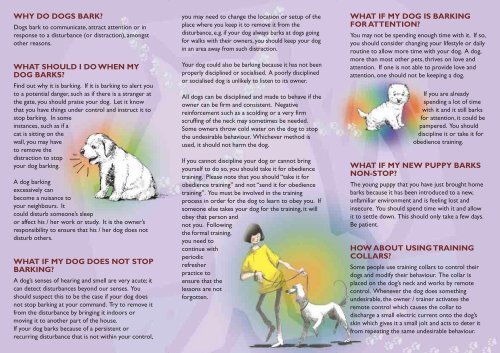Table of Contents
Living in Singapore can be a delightful experience, with its vibrant culture and modern cityscape. However, one common challenge that you may encounter is dealing with a barking dog in your neighborhood. It’s no fun to be constantly disturbed by the relentless barking of your neighbor’s dog, but fear not, for this article will provide you with some helpful tips on how to handle this situation with grace and understanding.

Understanding the Barking Behavior
Common Reasons for Barking
Barking is a natural form of communication for dogs, but excessive barking can be frustrating for both dog owners and their neighbors. Understanding the reasons behind a dog’s barking can help in addressing the issue effectively. Some common reasons for barking include alerting, fear or anxiety, boredom, loneliness, territorial instincts, or seeking attention. By identifying the underlying cause of the barking, you can take appropriate measures to address it.
Understanding the Singapore Context
Living in a densely populated city like Singapore can amplify the impact of a barking dog. The close proximity of residential areas and the cultural expectation of maintaining a peaceful environment create a unique challenge when it comes to dealing with barking dogs. It is essential to be sensitive to the needs and concerns of your neighbors while finding effective solutions to manage your dog’s barking behavior.
Impact of Excessive Barking
Excessive barking can have various negative effects, both on the dog and the community. Dogs that are left untrained or are constantly barking can experience increased stress levels, which may lead to behavior problems or even physical health issues. For neighbors, the constant noise can cause disturbances, affecting their quality of life and potentially straining relationships within the community. It is crucial to address excessive barking promptly to maintain harmony within your neighborhood.
Working with Your Neighbors
Approaching the Situation with Empathy
When dealing with the issue of a barking dog, it is important to approach the situation with empathy. Understand that your neighbors may be experiencing frustration or annoyance due to the noise. Put yourself in their shoes and try to empathize with their perspective. This will help foster a more constructive and cooperative approach to finding a solution to the problem.
Engaging in Open Communication
Open and honest communication is key when working with your neighbors to address a barking dog. Initiate a conversation with them to discuss the issue and express your willingness to resolve the problem. Take the time to actively listen to their concerns and be receptive to their suggestions. By maintaining open lines of communication, you can build trust and develop a collaborative approach towards finding a solution.
Seeking Mediation or Intervention
If direct communication with your neighbors does not yield satisfactory results, it may be beneficial to seek mediation or intervention. Singapore offers various avenues for dispute resolution, such as the Community Mediation Centre. Mediators can facilitate constructive conversations between you and your neighbor, guiding you towards a mutually agreeable solution. If the barking dog persists and becomes a serious nuisance, legal intervention may be necessary. Familiarize yourself with the relevant regulations and seek guidance from local authorities if required.

Addressing the Root Cause
Identifying the Trigger Points
To effectively address excessive barking, it is essential to identify the trigger points that cause your dog to bark excessively. Observe your dog’s behavior and try to determine the specific situations or stimuli that provoke the barking. Is your dog barking at certain times of the day, specific noises, other animals, or when left alone? Understanding the triggers will help you tailor your approach to managing the barking behavior.
Creating a Distraction-Free Environment
Minimizing potential distractions can help reduce the frequency of barking episodes. Create a calm and comfortable environment for your dog by providing adequate exercise, mental stimulation, and appropriate outlets for their energy. Ensure their basic needs, such as food, water, and shelter, are met. By addressing these factors, you can help prevent boredom or anxiety-induced barking.
Implementing Behavior Modification Techniques
Behavior modification techniques can be effective in addressing excessive barking. Positive reinforcement training methods, such as reward-based training, can help teach your dog alternative behaviors and commands. Seek professional guidance or consider enrolling in obedience classes to learn techniques specifically designed to address barking issues. Consistency and patience are key when implementing behavior modification techniques, so be prepared to invest time and effort into training your dog.
Training and Socialization
Importance of Proper Training
Proper training is crucial for preventing and managing excessive barking in dogs. A well-trained dog understands and responds to commands, making it easier to redirect their behavior when barking becomes excessive. Training should focus on teaching your dog appropriate communication cues, such as “quiet” or “enough.” Consistent and positive reinforcement training methods, coupled with patience and perseverance, can help shape your dog’s behavior and reduce barking incidents.
Seeking Professional Help
If you are struggling to manage your dog’s barking behavior on your own, seeking professional help is a viable solution. Animal behaviorists or professional dog trainers can provide expert guidance and tailored strategies to address excessive barking. They can assess your dog’s specific needs and behaviors, identifying underlying causes and developing customized training plans. Collaborating with professionals can be advantageous in achieving long-term behavioral changes.
Exposing the Dog to Social Situations
Socialization plays a significant role in preventing excessive barking. By gradually introducing your dog to different environments, people, and animals, you help them develop confidence and adaptability. Exposing your dog to various social situations can reduce anxiety and fear-based barking. Organize playdates with other dogs or frequent dog-friendly locations to promote positive social experiences, helping your dog become more comfortable in different situations.

Using Noise-Cancelling Devices
Understanding Noise-Canceling Technology
Noise-canceling devices can be an effective tool in reducing the impact of excessive barking on both your household and your neighbors. These devices work by emitting sounds that mask or cancel out the barking noises, creating a quieter environment. Some devices also utilize advanced technology that specifically targets and reduces dog barking sounds. Understanding how noise-canceling technology works can help you choose the most suitable device for your needs.
Researching Available Products
When considering noise-canceling devices, it is essential to research and compare the available options. Look for devices that are specifically designed to address dog barking noises and have positive reviews from users. Consider factors such as the device’s range, versatility, ease of installation and use, and effectiveness in reducing barking sounds. Each device may have distinct features, so finding the one that aligns with your requirements is crucial for optimal results.
Installing Noise-Canceling Features
Once you have selected a noise-canceling device, follow the manufacturer’s instructions for installation and usage. Place the device strategically in the area where your dog spends the most time or where the barking noise is most disruptive. Test the device and make adjustments as needed to achieve the desired reduction in barking noise. Keep in mind that noise-canceling devices are not a standalone solution and should be used in conjunction with other training and management techniques.
Utilizing Anti-Barking Devices
Types of Anti-Barking Devices
Anti-barking devices are designed to deter or interrupt barking behavior, discouraging dogs from excessive barking. There are various types of anti-barking devices available, including ultrasonic devices, citronella collars, and vibration collars. Ultrasonic devices emit high-frequency sounds that are unpleasant to dogs, citronella collars release a burst of citronella scent when the dog barks, and vibration collars provide a gentle vibration as a deterrent. Each type of anti-barking device has its own mechanism and effectiveness, so careful consideration is necessary before selecting one.
Effectiveness and Limitations
While anti-barking devices can be helpful in managing excessive barking, they may not be effective for every dog. Some dogs may become desensitized to the devices over time, rendering them less effective. Additionally, certain factors, such as the dog’s temperament, sensitivity to stimuli, and underlying reasons for barking, can influence the effectiveness of these devices. It is important to use anti-barking devices in conjunction with training and behavior modification techniques for long-term results.
Controversies Surrounding Anti-Barking Devices
It is important to note that there are controversies surrounding the use of certain anti-barking devices, particularly those that deliver punishment or discomfort to the dog. While these devices may temporarily suppress barking, they can also elicit fear or anxiety in dogs, potentially leading to negative behavioral side effects. It is essential to prioritize your dog’s well-being and choose anti-barking devices that utilize humane and positive reinforcement methods.

Legal and Community Options
Understanding the Regulations in Singapore
In Singapore, there are regulations in place to address excessive noise, including barking, under the Environmental Public Health Act. Familiarize yourself with the specific regulations governing noise levels and nuisance complaints in your area. It is important to understand your rights and obligations as a dog owner and the potential consequences if the barking issue is not adequately resolved.
Reporting to the Local Authorities
If your efforts to manage your dog’s barking behavior have been unsuccessful, or if the barking is causing significant distress to you or your neighbors, you may consider reporting the issue to the local authorities. Contact your local town council or the Agri-Food & Veterinary Authority of Singapore (AVA) to seek guidance and file a complaint if necessary. Be prepared to provide specific details and evidence of the barking incidents when making a report.
Engaging with Community Support Groups
Engaging with community support groups can provide valuable resources and assistance when dealing with a barking dog issue. Local animal welfare organizations or dog owner communities may offer guidance, educational materials, or even support groups that can help address the issue. Sharing experiences and seeking advice from like-minded individuals can make the process of managing excessive barking more manageable.
Considering Neighbourhood Etiquette
Being Mindful of Noise Levels
Maintaining good neighborly relations involves being mindful of the noise levels within the community. Apart from addressing your dog’s excessive barking, it is essential to be aware of other potential noise sources, such as loud music, household appliances, or construction work. Strive to minimize noise disturbances by keeping volumes low and considering the impact of your activities on your neighbors’ peace and quiet.
Keeping the Dog Occupied
Boredom and lack of stimulation can contribute to excessive barking. Ensure that your dog is adequately occupied with toys, puzzle feeders, or interactive games that provide mental and physical stimulation. Engaging your dog in regular exercise and playtime can help release excess energy and reduce the likelihood of barking due to restlessness.
Implementing Bark Control Measures
Incorporating bark control measures can limit the impact of your dog’s barking on the neighborhood. Establish a designated area for your dog to alleviate their territorial instincts and limit their exposure to potential triggers. Install barriers or use visual and auditory distractions, such as curtains or white noise machines, to create a barrier between your dog and external stimuli. These measures can help minimize the sound transmission and reduce the overall noise levels.

Exploring Soundproofing Solutions
Soundproofing Techniques for Walls
Soundproofing walls can significantly reduce the transmission of sound, including your dog’s barking, to neighboring units. Insulating materials, such as acoustic panels or foam, can be installed on walls to absorb and dampen sound waves. Additionally, sealing any gaps or cracks in the walls can help prevent sound leakage. Consider consulting professionals or researching DIY soundproofing methods to find the most suitable approach for your home.
Soundproofing for Windows and Doors
Windows and doors are common areas of sound leakage. Installing double-glazed windows or soundproof curtains can help reduce the transmission of sound, creating a more peaceful indoor environment. Weatherstripping or sealants can be used to minimize gaps and improve the soundproofing effectiveness of doors. These modifications can contribute to a quieter living space and minimize the impact of your dog’s barking on your neighbors.
Using White Noise Machines
White noise machines emit a consistent background noise that can help mask or drown out sounds, including barking. By creating a soothing ambient sound, these machines can help minimize the disturbance caused by your dog’s barking. Place the white noise machine in the area where the barking noise is most pronounced, or consider using multiple machines strategically placed throughout your home for maximum effectiveness.
Seeking Professional Help
Engaging Animal Behaviorists
When all efforts to address your dog’s excessive barking have been exhausted without satisfactory results, engaging the services of an animal behaviorist can be beneficial. Animal behaviorists are trained professionals who specialize in understanding and modifying animal behavior. They can assess your dog’s specific situation, identify underlying issues, and develop a tailored behavior modification plan to address the excessive barking.
Consulting Veterinarians
Veterinarians play a crucial role in addressing behavioral issues in dogs, including excessive barking. They can conduct a thorough examination to determine if any underlying medical conditions might be contributing to the barking behavior. Additionally, veterinarians can recommend medication or treatments that can help manage anxiety or other behavioral issues that may be causing the excessive barking.
Considering Doggy Daycare or Boarding
In some situations, temporarily enrolling your dog in a reputable doggy daycare or boarding facility can provide relief for both you and your neighbors. These facilities often offer structured activities, supervised playtime, and socialization opportunities, which can help alleviate boredom and anxiety-induced barking. As a result, this temporary solution may mitigate the impact of excessive barking on your immediate community, allowing you time to implement comprehensive training and behavior modification plans.
Dealing with a barking dog in Singapore requires a multifaceted approach involving understanding, communication, training, and potentially seeking professional assistance. By addressing the root causes of excessive barking and implementing appropriate measures, you can create a harmonious environment for both your dog and your neighbors. Remember, a peaceful and considerate neighborhood benefits everyone involved.



